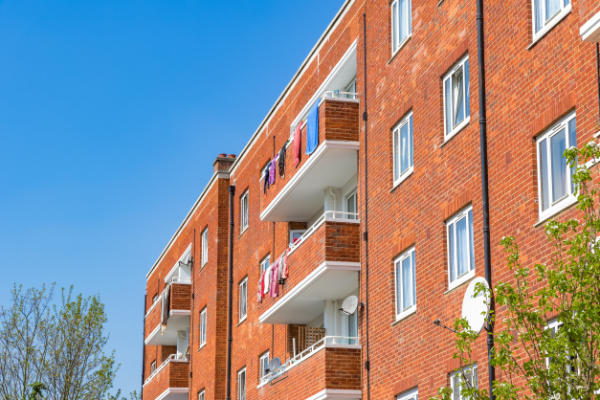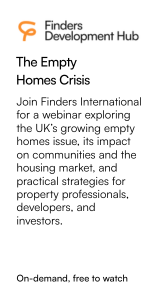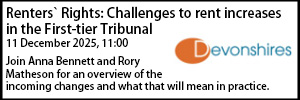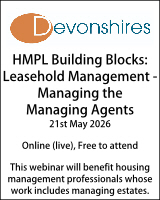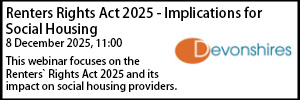Improvement notices under s.12 Housing Act 2004
- Details
The First Tier Tribunal recently considered the use of Improvement Notices under s.12 of Housing Act 2004 to address concerns regarding the fire safety of residential property containing cladding similar to that present on Grenfell Tower. Archie Maddan analyses its ruling.
Raingate Limited v London Borough of Camden (LON/ooAG/HIN/2022/0019) (20 March 2024)
The applicants were the owners of a mixed-use property situated at Star Yard, off Chancery Lane in London. The building largely consisted of commercial premises but a small proportion of the first floor of the building was flats occupied by leaseholders and tenants. The building was believed by London Borough of Camden, who are the Local Housing Authority (“LHA”), to be just over 18 metres in height, although this was later denied by the owners. The building was of an unusual configuration being two blocks joined by a “bridge”. This bridge contained several of the flats.
Crucially, the bridge was partially clad in Category 3 aluminium composite material (“ACM”) similar or identical to that present at Grenfell Tower. PIR insulation was also present.
Following government instructions to audit all residential buildings over 18m in height the LHA contacted the owners’ managing agents to gather information regarding the building. Following this process it became clear that the building contained potentially dangerous cladding materials. The managing agents were asked by the LHA to obtain an expert assessment of the building and the fire safety of its construction. The LHA provided the managing agents with a list of suitable experts to carry out the assessment.
The expert assessments of the building commissioned by the managing agents confirmed that unsafe materials were present on the building’s cladding and wall system. However the expert reports concluded that the overall fire safety of the residential parts of the building was acceptable despite the presence of unsafe cladding.
The LHA’s environmental health officer (“EHO”) was not satisfied by the expert reports obtained by the managing agents. In particular the LHA officer noted that the build up of the walls of the bridge containing residential premises remained unclear. The LHA officer noted that although the ACM cladding only covered a relatively small proportion (around 4%) of the entire building’s external walls, large parts of the external walls of the residential flats were covered in the material (even the underside of the bridge was clad in what appeared to be ACM).
There was quite extensive correspondence between the LHA officers and the managing agents regarding the conclusions that could be safely drawn from the reports obtained by the managing agents. The LHA remained unsatisfied about the fire safety of the flats. The LHA officer inspected the flats and other parts of the building and carried out a Housing Health and Safety Rating System (“HHSRS”) assessment of the premises under Part 1 of the Housing Act 2004. As a result of that assessment the LHA served an Improvement Notice (“the notice”) grounded upon the presence of Category 2 fire safety hazards present at the property.
The notice gave detailed reasons for the service of the notice which can be summarised as being a lack of reliable information about the construction and build up of the external walls of the flats and the effect upon the overall fire safety of the building for the occupants of the flats.
The Notice required compliance with a schedule of works. The works fell into two parts which were in the alternative. Either the building owner could elect to remove the unsafe elements of the wall system including in particular the ACM cladding OR in the alternative the owner could commission further expert reports to provide clear evidence of the fire safety of the building’s external walls. Such a report was to establish a successful BR135 classification (which would be impossible with ACM present) or was to consist of a full Fire Risk Assessment of the External Walls (“FRAERW”) in accordance with the PAS 9980:2022 standard adopted following the Grenfell fire. The notice specified the elements of the wall structure that any expert report should address.
The building owner appealed the notice. The applicant’s grounds of appeal developed during the proceedings but by the final hearing the applicant’s case was put on the basis that the service of an Improvement Notice under s.12 of the Housing Act 2004 was not justified and that at most a Hazard Awareness Notice was appropriate.
The applicant’s case was advanced on the basis that the HHSRS assessment made by the LHA’s EHO was flawed and had rated the fire safety hazard as more serious that was appropriate taking into account the relevant guidance and worked examples. The applicant relied upon its own expert HHSRS assessment of the building which “scored” the hazard at a lower level of seriousness; the applicant’s expert also expressed the view that the level of fire safety hazard present at the property would not normally justify the service of an Improvement Notice. The applicant’s expert also advised in his report that the investigation and report works required by the notice as the alternative to removal of the dangerous material were too extensive and that lesser reporting was appropriate.
The appeal was heard over 3 days with the applicant represented by leading counsel. The Tribunal heard full oral evidence and cross-examination. The applicant initially attempted to have the LHA’s EHO evidence excluded on the basis that it was expert evidence and not admissible. The Tribunal rejected that proposition on the basis that the LHA must be able to give evidence about why its officer had served the Improvement Notice.
The Tribunal rejected the applicant’s appeal against the LHA’s Improvement Notice. It did allow some amendment to the wording of the report requirement.
The Tribunal’s decision contains interesting comments regarding the use of Improvement Notices in unsafe cladding situations.
The applicant’s primary case was that the level of hazard was not high enough to justify use of an Improvement Notice. Considerable evidence was considered relating to the HHSRS assessments made by the LHA’s EHO and the applicant’s highly regarded expert. The LHA’s HHSRS assessment found the level of hazard to be Category 2 Band D, whilst the applicant expert found the hazard to be much lower, as Band F. The Tribunal did not make its own formal HHSRS assessment of the fire safety of the premises (despite there being a full site inspection). The Tribunal concluded that, taking into account various features of the building, the actual level of hazard lay at a point between the two different scores. The LHA EHO had assessed greater likelihood than was supported by the evidence; however the applicant expert had also incorrectly assessed the likelihood and placed it as too low.
The detailed scoring of the fire safety hazard present at the premises was however not the determinative matter. The Tribunal placed greater emphasis upon whether the LHA had been “wrong’ to use the Improvement Notice route to address the issues with the building. It is in this part of its decision that the Tribunal took into account the circumstances particular to cladding cases following the Grenfell fire. The Tribunal was unwilling to accept the applicant expert’s evidence about the “usual” use of s.12 Improvement Notices for low band category 2 hazards:
“89. The role of the Tribunal is to consider whether the council decision was “wrong.” However, we consider that since a HHSRS calculation depends on the application of a number of different judgements, if we do not agree with one of those judgements it will not necessarily mean that the calculation is “wrong” in the sense that it needs to be overturned. In this case both Mr Clark and Dr Battersby agreed that there is a Category 2 hazard. This difference is that as at August 2022, Mr Clark assessed this to be a Category 2 Band D hazard and Dr Battersby assessed it to be a Category F hazard. Dr Battersby’s evidence was that local authorities would rarely issue an improvement notice for a Band F hazard but we take the view that this approach is too generalised.
In a case which concerns ACM cladding and where there had been something of a breakdown in communications between the EHO and the building owner, we consider that the service of an improvement notice could properly be regarded as the best form of action by Camden.
90. It is important to remember the context for the focus by councils on buildings exceeding 18 metres following the Grenfell Tower fire. Although it is not
accepted that this building exceeds 18 metres, when Mr Belding submitted his web form in 2021 he stated that it did and so it was reasonable, in terms of context, for Mr Clark to proceed on that basis.
91. In addition to the requirement in section 3(1) to keep housing conditions under review, section 3(3) requires that for the purpose of carrying out that duty, local authorities must comply with any directions given by the appropriate national authority and as we have seen in May 2018, the Secretary of State gave such a direction in respect of buildings over 18 metres with ACM and to take all necessary enforcement action.
92. Also relevant to the context is the addendum to the operating guidance and in particular the MHCLG advice to building owners which said that “the clearest way to ensure the safety of residents is to remove all ACM, including small or partial areas of ACM, and replace it with a safe material. This remains the most appropriate remediation solution.”
The Tribunal appears to be indicating that where unsafe materials similar to those at Grenfell Tower are present a LHA will be accorded latitude for any decision to serve a s.12 Improvement Notice. In the present case the LHA had required that the building owner either removed the unsafe materials or established that they were safe to remain on the building. It should also be noted that this building was arguably in the 18m category and so caught by specific direction from central government to ascertain its fire safety.
It is probably not possible to go so far as to specifically label the Tribunal’s approach as “precautionary”. What is clear is that building owners seeking to appeal s.12 Improvement Notices served on 18m buildings with ACM or other unsafe materials will have to do more than rely upon marginal arguments relating to HHSRS scoring and “usual” practice under HA 2004 Part 1. The presence of even small quantities of unsafe materials on residential buildings over 18m in height will likely justify proof of safety to “FRAEW” standard. Reliance upon standard “old school” HHSRS assessments without the specific, post-Grenfell, examination methods for external walls will not be sufficient to establish safety where ACM or similar is present. The caution adopted by Camden Council in the present case was not found to have been “wrong”.
The Tribunal also made interesting comments about some other matters. The potential effects of the presence of ACM upon the mental health of occupiers as a factor in considering hazards was the subject of argument during the hearing. The Tribunal expressed sympathy with the LHA’s approach of taking it into account whilst formally ruling out consideration:
“93. We also have some sympathy with Mr Clark in his concern for the effect of the presence of ACM on the mental health of occupiers. Although Mr Clark was criticised for this conclusion we think that as an observation it is justifiable and in fact the alteration in the spread of harms decided by Mr Clark was not significant. However, we agree with Dr Battersby that as currently drafted, the HHSRS operating guidance does not accommodate its inclusion. We hope this is a matter that can at least be considered in the work being undertaken to refresh the HHSRS system.”
The Tribunal also dealt with the relevance of the majority of the building being commercial in nature and found that this was irrelevant to the assessment of fire risk in mixed use buildings:
“96. As was explained at the beginning of this decision, the purpose of the HHSRS is to ensure that residential premises provide a safe and healthy environment for occupiers and visitors. This goes some way to explaining the difference between the building experts and the EHOs. We recognise that Mr Alves has advised on the safety of numerous residential high-rise buildings but it is notable that in nearly 100% of those buildings he has advised that ACM cladding should be removed. In our view his treatment of this building as being commercial with a small element of residential is not sufficient justification for a departure from his usual approach to the preservation of life and health.”
(Mr Alves was the applicant’s other expert witness, being an engineer and leading expert on building facades and related fire safety issues).
The main conclusion to be drawn from this decision is that, as has been indicated in previous Tribunal decisions, any attempt to retain unsafe materials in residential buildings, especially tall ones, will require clear and conclusive proof of safety. This approach is in line with the technical guidance produced since the Grenfell Tower fire. It is likely that the volume of s.12 Improvement Notices being served for cladding issues will now subside as auditing is concluded and the new regulatory environment comes into force. However, for those thinking of challenging any such notices, this decision from a strongly composed Tribunal is a marker of the high burden to be discharged if wanting to retain any unsafe materials on residential buildings.
Archie Maddan is a barrister at 5 Pump Court. He successfully represented the respondent local authority.










